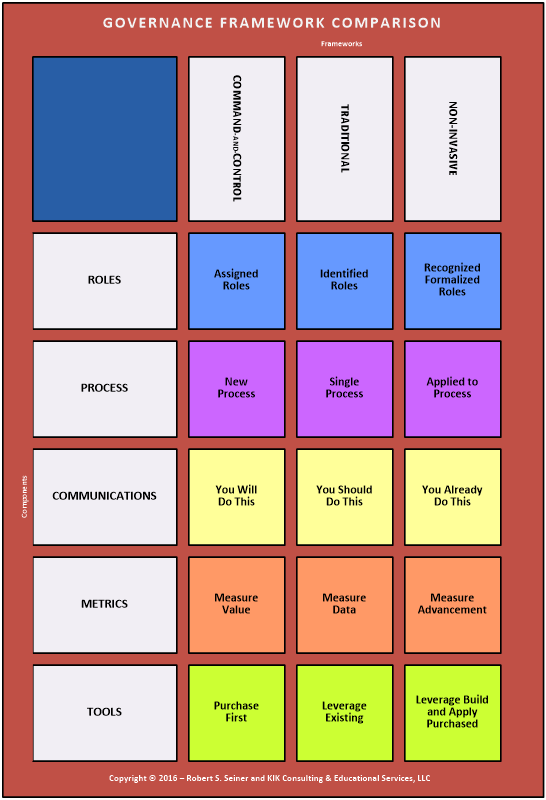 Three approaches to implement data governance include 1) the Command and Control approach, 2) the Traditional approach, and 3) the Non-Invasive approach. This article compares and contrasts the approaches and quickly summarizes each approach. The approaches are broken down by the primary components of a data governance program spelled out in my recent articles that address a framework for Non-Invasive Data Governance™ [part 1, part 2].
Three approaches to implement data governance include 1) the Command and Control approach, 2) the Traditional approach, and 3) the Non-Invasive approach. This article compares and contrasts the approaches and quickly summarizes each approach. The approaches are broken down by the primary components of a data governance program spelled out in my recent articles that address a framework for Non-Invasive Data Governance™ [part 1, part 2].
The original comparison of the approaches can also be found in my September 2016 installment of my Real-World Data Governance webinar series with Dataversity – Successful Data Governance Models and Frameworks. The diagram I used in that webinar is shown in figure 1 below.
Roles
- In a Command and Control approach to Data Governance: Roles are assigned to people, often as something new. Immediately, data governance is perceived as something that is over and above the existing levels of responsibility and thoughts turn to how much time it will take and how data governance competes with completing their job function.
- In a Traditional approach to Data Governance: People are identified into roles based on seniority and ownership of systems and data resources. Responsibilities are often spelled out in policy requiring governance of formal charters and designation of people into the specific roles called out by the data governance program.
- In a Non-Invasive approach to Data Governance – People are recognized into roles based on their existing relationship to the data. People who define data are assisted during the task of defining new data. People who produce data understand the impact of the data they produce. Data users are formally educated, made aware of and expected to follow all rules associated with using data. Being recognized for something brings with it a positive connotation and positive expectations.
Process
- In a Command and Control approach to Data Governance: All processes are new and governed. Data governance is all about taking control of processes and redefining all processes specifically to govern the data. Often times people are told that data governance is the reason we are following the process and spells out penalties for not following process.
- In a Traditional approach to Data Governance: There is a single process for how to govern data. Often times the process is labeled “The Data Governance Process.” The process is applied to every activity and the process is recognized as being the main dimension of the program. By calling processes Data Governance Processes, the discipline is singled out as the reason for having delays.
- In a Non-Invasive approach to Data Governance: Governance is applied to existing and new processes. Processes are not given the label of being a data governance process; they are called by their original name – “request for access,” “issue resolution,” “project methodology,” and so on. When new processes are defined, they too are governed from the beginning.
Communications
- In a Command and Control approach to Data Governance: Data governance is communicated with a tone of “you will do this.” Data governance is new to the people and the organization and people are told exactly what to do in an authoritative manner. This is not always bad – and in fact some organizations require strong top down direction and the demand for improved behavior.
- In a Traditional approach to Data Governance: Data governance is communicated as something that you should do. Often times, data governance is spelled out in policy and a directive is given for a specific group of people to take primary responsibility for governing data across the organization.
- In a Non-Invasive approach to Data Governance: Data governance is communicated as something we already do but can do better. Since people are recognized for their relationship to the data, most responsibilities are conveyed through the formalization of activities that people already have associated with how they define, produce, and use data.
Metrics
- In a Command and Control approach to Data Governance: Organizations measure the value of data governance through return on investment (ROI). In other words, the expectation is that data governance will bring in money directly from the results of data governance through improved capabilities, or save the organization money directly due to the governance of data. These results are often difficult to demonstrate.
- In a Traditional approach to Data Governance: The quality of the data is measured as the way to determine the effectiveness of data governance. Typically, organizations benchmark the quality of data definition, production, and usage, and put metrics in place to measure the improvement of costs associated with each of these activities.
- In a Non-Invasive approach to Data Governance: The effectiveness of data governance is measured through the value demonstrated from existing and new information-based resources. Return on investment is typically measured from improved operational efficiency and effectiveness of analytical capabilities brought forth from other investments in information technology.
Tools
- In a Command and Control approach to Data Governance: Tools are purchased early, raising the expectation level of the organization. With this approach, the tool becomes the focus of the program and people are expected to learn the tool and integrate the tool into daily routine and process. Data Governance tools are often selected without a complete understanding of tool capabilities and requirements.
- In a Traditional approach to Data Governance: Existing tools are leveraged before new tools are acquired to drive data governance. Organizations following this approach look first to the tools that they have in place and focus on specific activities such as improving data definition through modeling, data production through improved integration capabilities, and data usage through improvement of data protection capabilities.
- In a Non-Invasive approach to Data Governance: Existing tools and industry-proven templates and models are leveraged to define requirements for future tool needs. The non-invasive approach calls for developing tools internally and leveraging existing industry templates that address specific governance needs as a means of flushing out detailed tool purchase requirements.
In this article I have quickly compared three of the most-effective, but very different approaches to implementing data governance programs in organizations with fairly to severely complex data environments. There are upsides and downsides to each of the approaches which I shared in the webinar.
The quick paragraphs above call out the most significant differences in the approaches when compared using the primary components of the Non-Invasive Data Governance framework shared in TDAN.com earlier this year.

